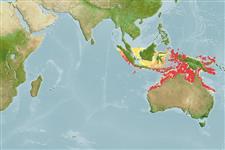Environment: milieu / climate zone / depth range / distribution range
Écologie
marin récifal; profondeur 40 - 80 m (Ref. 75154). Tropical; 4°N - 24°S, 91°E - 154°E (Ref. 55)
Eastern Indian Ocean: known only from a few specimens collected at Indonesia (off Sumatra and Sulawesi) and west of Kuri Bay, Western Australia.
Taille / Poids / Âge
Maturity: Lm ? range ? - ? cm
Max length : 30.0 cm TL mâle / non sexé; (Ref. 55)
Épines dorsales (Total): 10; Rayons mous dorsaux (Total): 13-14; Épines anales 3; Rayons mous anaux: 8 - 9. Snout somewhat pointed, dorsal profile of head sloping steeply. Preorbital bone relatively narrow, its width usually slightly less than eye diameter. Preopercular notch and knob poorly developed. Scale rows on back rising obliquely above lateral line. Generally red or pink when fresh; fins are red or orange. Juveniles under 10 cm SL have blackish caudal fin lobe tips, frequently also a crescentic blackish blotch in the middle of the caudal fin, sometimes also with a yellowish mid-lateral stripe extending from the rear edge of the operculum to the middle of the caudal fin.
Adults inhabit deeper reef areas. They occur solitarily or in small groups.
Life cycle and mating behavior
Maturité | Reproduction | Frai | Œufs | Fécondité | Larves
Allen, G.R., 1985. FAO Species Catalogue. Vol. 6. Snappers of the world. An annotated and illustrated catalogue of lutjanid species known to date. FAO Fish. Synop. 125(6):208 p. Rome: FAO. (Ref. 55)
Statut dans la liste rouge de l'IUCN (Ref. 130435)
Menace pour l'homme
Harmless
Utilisations par l'homme
Pêcheries: commercial
Plus d'informations
PaysZones FAOÉcosystèmesOccurrencesIntroductionsStocksÉcologieRégime alimentaireÉléments du régime alimentaireConsommation alimentaireRation
Noms communsSynonymesMétabolismePrédateursÉcotoxicologieReproductionMaturitéFraiRassemblement de ponteFéconditéŒufsDéveloppement de l'œuf
RéférencesAquacultureProfil d'aquacultureSouchesGénétiqueElectrophoresesHéritabilitéPathologiesTraitementNutrientsMass conversion
CollaborateursImagesStamps, Coins Misc.SonsCiguateraVitesseType de nageSurface branchialeOtolithesCerveauxVision
Outils
Articles particuliers
Télécharger en XML
Sources Internet
Estimates based on models
Preferred temperature (Ref.
123201): 25.9 - 27.9, mean 27.3 °C (based on 75 cells).
Phylogenetic diversity index (Ref.
82804): PD
50 = 0.5000 [Uniqueness, from 0.5 = low to 2.0 = high].
Bayesian length-weight: a=0.01479 (0.00706 - 0.03101), b=2.97 (2.81 - 3.13), in cm total length, based on LWR estimates for this Genus-body shape (Ref.
93245).
Niveau trophique (Ref.
69278): 3.8 ±0.6 se; based on size and trophs of closest relatives
Résilience (Ref.
120179): Milieu, temps minimum de doublement de population : 1,4 à 4,4 années (Preliminary K or Fecundity.).
Fishing Vulnerability (Ref.
59153): Low vulnerability (20 of 100).
Nutrients (Ref.
124155): Calcium = 46.2 [30.7, 63.9] mg/100g; Iron = 0.374 [0.241, 0.560] mg/100g; Protein = 18.5 [17.0, 19.8] %; Omega3 = 0.151 [0.107, 0.208] g/100g; Selenium = 57.7 [39.0, 82.9] μg/100g; VitaminA = 170 [33, 621] μg/100g; Zinc = 0.486 [0.389, 0.671] mg/100g (wet weight);
